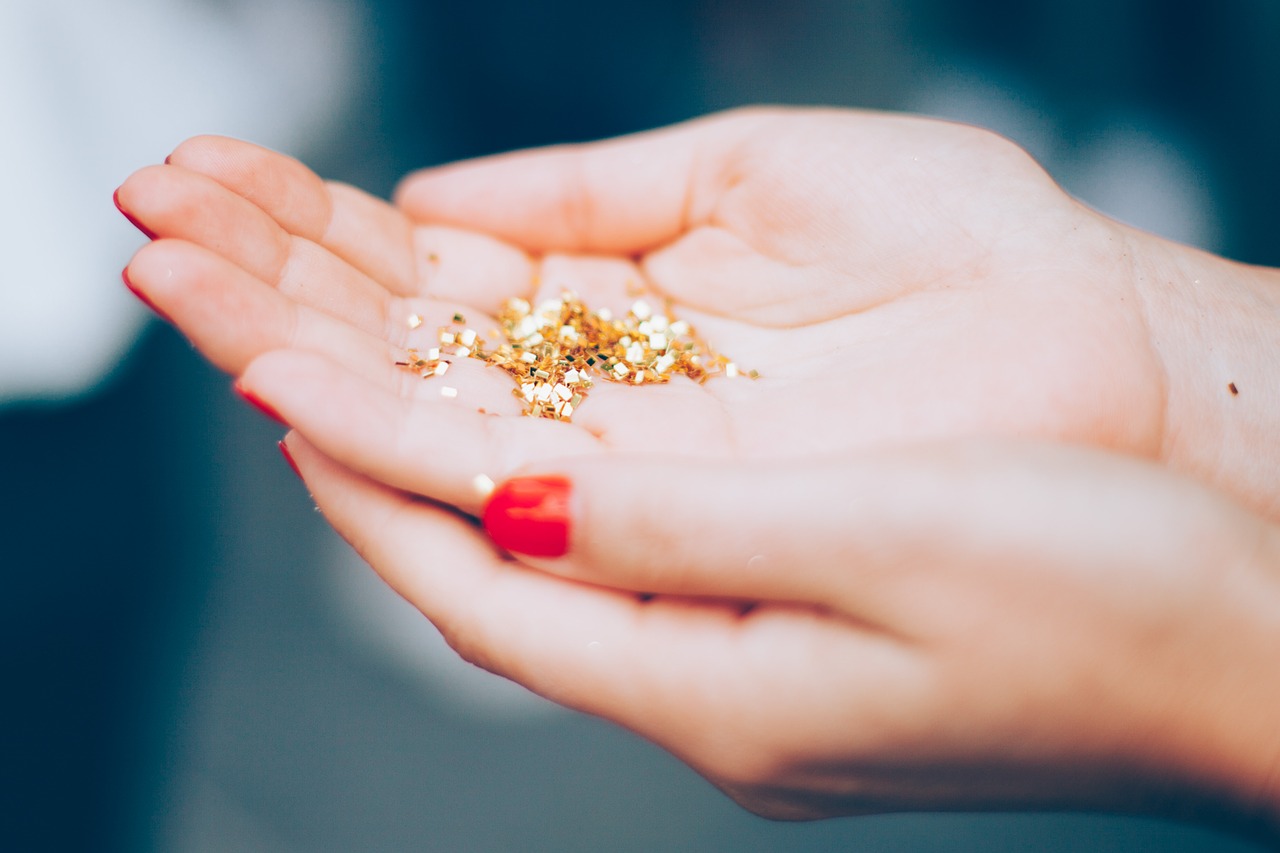Should we get rid of glitter?
Microbeads were shunned for their role in water pollution. Is everyone’s favorite sparkly stuff next?
Corryn Wetzel • March 6, 2020

Glitter is showing up in oceans but with unclear impacts, the debate over glitter is heating up [Credit: Pexels | Pixabay Free Use License]
Are you ready to live your life with a little less sparkle?
Glitter is glamorous, eye-catching — and potentially harmful to the environment. A small but growing number of activists and researchers are concerned about glitter’s role as a water pollutant and say it’s time to give up the shiny plastic flecks that add shimmer to everything from cosmetics to automobile paint.
While other microplastics –– plastic pieces smaller than the size of Lincoln’s head on a penny –– have become high-profile targets of environmental activists in recent years, glitter has largely escaped public scrutiny. That’s not only because so many people love to sparkle; it’s also because glitter is less common in ocean waters than plastics like microbeads, the tiny and now-controversial plastic balls commonly added to exfoliating products like face washes and soaps. But there is a growing recognition that glitter is a problem, too, especially because it’s typically made from a type of dense plastic called polyethylene terephthalate, or PET — the same plastic used in most disposable water bottles.
Glitter’s journey isn’t straight from the sink drain to the ocean. In most cases, glitter must first pass through a wastewater treatment plant. But glitter “manages to evade screening stages” at some treatment plants, says Olga Pantos, a marine biologist who studies microplastics at the Institute of Environmental Science and Research in New Zealand.
If glitter makes its way into processed wastewater, it can sink and settle into sludge. From there, the glitter might be resuspended in the water if agitated, stay trapped in the sludge for a long time, or be transported to land if sludge is used to fertilize crops.
“The key thing,” says Pantos, “is once it’s gone down your sink, it is going to the environment. It’s not gone, it’s just moved somewhere else.” Although there is some evidence suggesting these certain toxins can disrupt hormones, the research isn’t conclusive. But even without leaching, glitter can cause issues for marine life.
Glitter can end up in the stomachs of filter feeders like oysters and fish, accumulating and blocking their digestive tracts, Pantos explains. Microplastics like glitter can break down further, traveling up through the food chain and ending up in our dinner.
These tiny microplastics have become a major concern because of their ubiquity and durability. Hundreds of thousands of tons of microplastics enter oceans every year, though estimates vary widely. Some of those microplastics start small, like glitter or microbeads, while others break down from larger items like bottles and bags. The biggest sources are synthetic fibers in clothing and commercial plastic pellets called nurdles. Still, glitter plays a role in adding microplastics to the environment.
The case against glitter is strong enough that environmental anthropologist Trisia Farrelly of Massey University in New Zealand has been campaigning for the public to stop using glitter made from PET.
Like many other microplastics, she says, glitter is “avoidable, it’s unnecessary, it’s nonrenewable and it’s non-recyclable.” Anything that falls into these categories, she says, should be avoided and discouraged, though she doesn’t go so far as advocating an outright ban.
“If glitter is one of those things that help us think more carefully about this much, much bigger, scary category of intentionally added and primary microparticles or plastics like microbeads, then that’s a good thing,” says Farrelly.
Pantos agrees, saying that though glitter isn’t the main offender when it comes to ocean-accumulated microplastics, it “helps raise the issue into people’s consciousness.”
Meral Yurtsever, a microplastic pollution researcher at Sakarya University in Turkey, is one of a handful of scientists looking at glitter’s environmental impact. She takes a stronger stance than many others in the field, saying, “I definitely think that PET glitter should be banned.”
Yet campaigns to minimize glitter use face challenges. Unlike plastic pellets or microbeads, glitter can be a social and cultural signifier. Farrelly is quick to point out that there are alternatives. A UK-based eco-glitter brand named Bioglitter offers products made primarily from Eucalyptus trees, though some glitters they offer contain small amounts of plastic. Major cosmetic retailers like Lush have been embracing more environmentally-friendly sources of sparkle for their products, like synthetic mica, a naturally glittery mineral.
We don’t need legislation or conclusive health evidence to start making better choices for the environment, says Farrelly.
“We know enough that we need to act now to reduce plastic pollution and land-based plastic pollution that is entering our biosphere,” says Farrelly, “So we need to do something dramatic about it.”
But given the widespread use of plastics — and the fact that plastic is easy to use and manipulate into a variety of products — it’s going to take a lot of work to start making an impact.
The same qualities that make plastics so useful are what create environmental risk, Pantos says. “That key characteristic of it being really resilient, very strong, long-lasting, that’s the reason people love it, but it’s also its downfall.”
3 Comments
I have some I bought years ago. Do you have any idea of the best way to safely dispose of it?
Lyn, that’s what I’m trying to find out, too. Many sites state the negative, but no one states what to do with the glitter we already have.
I’am waiting for more posts like this.